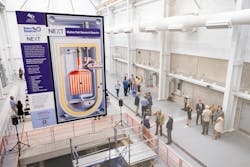Abilene Christian University Taking Lead in Molten Salt Nuclear Reactor Research
One of the nation’s smaller private universities, situated in a former hub city for cattle drives in northern Texas way more than a century ago, is building itself into a key center for advanced nuclear research that could drive small and safer reactor progress – maybe even nuclear microgrids – in the clean energy future.
Abilene Christian University (ACU) – with less than 5,000 undergraduate students — recently celebrated the grand opening of its Gayle and Max Dillard Science and Engineering Research Center, which is home to the school’s Nuclear Energy eXperimental Testing (NEXT) Laboratory. The lab also could be the future home for an advanced reactor testing project, pending approval by the U.S. Nuclear Regulatory Commission.
Many nuclear proponents, wary of the financial and logistical challenges of building utility-scale projects such as the $30 billion+ Vogtle expansion in Georgia, are aiming at the idea of micro and small modular reactors for carbon-free generation to powering microgrids, data centers and remote industrial and military sites.
What drives microgrids of the future? You tell us
The Microgrid 2024 Call for Speakers is still open: Submit session ideas until Oct. 2
Microgrid Conference coming April 2024 at the Baltimore Waterfront: Join the Revolution in Energy
Nuclear fission does not emit greenhouse gases during generation, so research focuses around its baseload, carbon-free capabilities. Early on, though, the planned ACU reactor would not be a true electricity generator.
“The research reactor will be used for research,” said Rusty Towell, a professor at ACU and director of the NEXT Lab. “So it will be turned on and off often. In the beginning, the reactor will be operated at very low power, so low we will need to turn on heaters to keep the salt molten. So it will not generate any electricity.”
The thermal energy produced, about 1 MW, will be released into the air. The primary work is focused on developing a proof-of-concept using molten salts in the fuel and cooling components of the reactor.
Molten salt reactors as safe alternative to water cooled
ACU has been working with molten salts for about seven years.
“We’ve had a flowing salt system for over five years and currently we have multiple systems using different salts to advance the technical readiness level of many critical elements needed to deploy a commercial molten salt reactor including flow meters, flanges, seals, level sensors, salt monitors, cover gas instrumentation and related hardware,” Towell said.
Graphite-moderated, fluoride salt flowing fluid is envisioned as possibly safer in nuclear energy compared to water-cooled reactors. If the electricity fails, the salt solidifies around the reactive uranium, preventing overheating, according to reports.
More than 75 people, including 45 ACU undergraduate students, work at the NEXT Lab.
“ACU has shown vision and is demonstrating leadership by pushing what has been (an on-paper only) reactor class for more than 50 years back into reality,” said David Holcomb, molten salt reactor technology leader at the Idaho National Laboratory (INL), during the grand opening of the research center on the Abilene campus.
“The success of your reactor will spark the imagination and provide inspiration to the world,” Holcomb added. “ACU has picked up the gauntlet in the creation of this science and engineering research center.”
Natura Resources, which is handling operational responsibilities for the molten salt reactor project, recently selected Zachry Nuclear Engineering to complete the engineering and design of the ACU molten salt reactor.
The participants also formed the Natura Resources Research Alliance, which, in addition to ACU, includes partners from the University of Texas at Austin, Texas A&M and the Georgia Institute of Technology. If and when completed, it would be the nation’s first working molten-salt reactor and the first university research reactor in many decades, according to reports.
Small nuclear as resilient, carbon-free microgrid possibility
Idaho National Lab, among others, has been touting the potential of small, advanced reactors for carbon-free microgrids of the future. Small modular reactors may offer reduced geographical footprints, lower construction costs and greater safety redundancies, proponents said, although some public resistance to such projects is almost assured.
Natural gas generators that power microgrids can be reliable, but they need a continuous, off-site and pipelined supply of fuel, the INL-Xendee report noted. Solar can provide some carbon-free electricity, but has low capacity factor and resiliency ratings.
Small reactor (SR) nuclear has a higher capacity factor and does not emit carbon dioxide in generation.
“SRs can be operated in combined heat and power mode to supply both heat and electricity,” the INL report read. “Most remote communities lack clean resources to fulfill their heating needs – small reactors can offer cogeneration –This cogenerating configuration can boost the economic performance of the system while also offering means to flexible operation.”
Track news about microgrids. Subscribe to the free Microgrid Knowledge Newsletter.
About the Author
Rod Walton, Microgrid Knowledge Head of Content
Managing Editor
For Microgrid Knowledge editorial inquiries, please contact Managing Editor Rod Walton at [email protected].
I’ve spent the last 15 years covering the energy industry as a newspaper and trade journalist. I was an energy writer and business editor at the Tulsa World before moving to business-to-business media at PennWell Publishing, which later became Clarion Events, where I covered the electric power industry. I joined Endeavor Business Media in November 2021 to help launch EnergyTech, one of the company’s newest media brands. I joined Microgrid Knowledge in July 2023.
I earned my Bachelors degree in journalism from the University of Oklahoma. My career stops include the Moore American, Bartlesville Examiner-Enterprise, Wagoner Tribune and Tulsa World, all in Oklahoma . I have been married to Laura for the past 33-plus years and we have four children and one adorable granddaughter. We want the energy transition to make their lives better in the future.
Microgrid Knowledge and EnergyTech are focused on the mission critical and large-scale energy users and their sustainability and resiliency goals. These include the commercial and industrial sectors, as well as the military, universities, data centers and microgrids. The C&I sectors together account for close to 30 percent of greenhouse gas emissions in the U.S.
Many large-scale energy users such as Fortune 500 companies, and mission-critical users such as military bases, universities, healthcare facilities, public safety and data centers, shifting their energy priorities to reach net-zero carbon goals within the coming decades. These include plans for renewable energy power purchase agreements, but also on-site resiliency projects such as microgrids, combined heat and power, rooftop solar, energy storage, digitalization and building efficiency upgrades.

